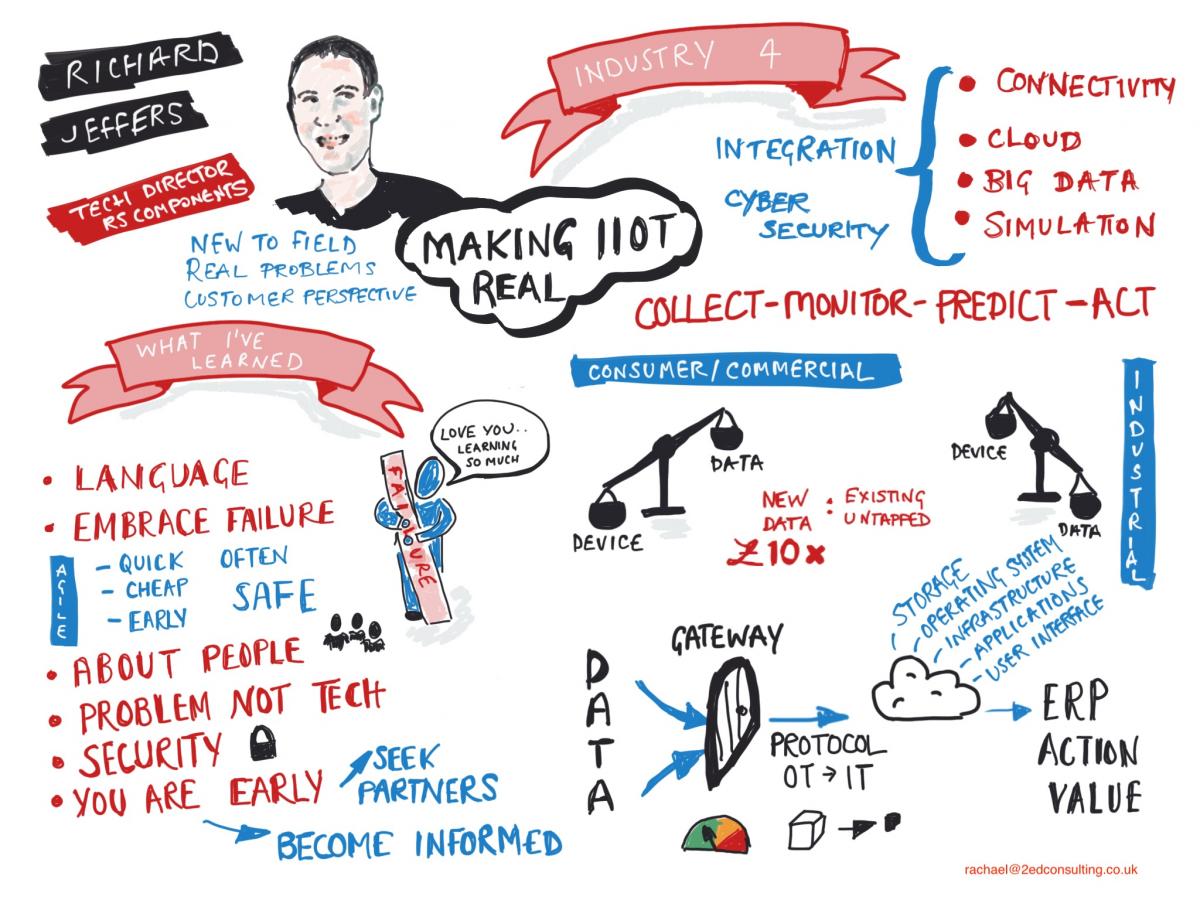Today’s businesses have an abundance of data at their fingertips, and tapping into it could be one of the smartest ways to address the challenges they face, including MRO procurement. In a webinar with Richard Jeffers, Director for Maintenance Solutions at RS, he discussed the role of technology in helping organisations move from data to decisions.
The Industrial Internet of Things (IIoT) promises to be a game-changer for businesses that can harness the power and insights of their data. Internet-enabled smart sensors are capturing data from manufacturing machinery and related processes and making it available to sophisticated business intelligence platforms. It can then be interrogated to help make evidence-based decisions, and could also lead to the development of real-time process refinements.
Collecting and analysing data isn’t new. But what sets the IIoT apart is the extent to which these processes can be automated. Not only are smart machines better than people at capturing data in real-time – they can also transmit it in real-time too; accuracy, reliability, and consistency of information can be counted on.
Achieving that level of consistency can seem like a significant undertaking requiring substantial investment. Sensors, smart machines, wireless networks, data analytics platforms, algorithms - it’s potentially a very long list. Even with some of the technological components in place, challenges remain. Disconnects between operational technology and IT departments can cause tension. Transmitting data via the internet into a cloud-based platform, for example, can fall foul of enterprise security protocols.
IIoT for MRO procurement
There are many benefits to the IIoT, both real and potential, relating to performance, optimisation, and process engineering. But there are other advantages, too.
“When it comes to Maintenance, Repair and Operations (MRO), so much of what takes place today would have been familiar to anyone working in the field 10 or 20 years ago,” says Richard Jeffers, Director for Maintenance Solutions at RS. “Something stops working, an engineer is summoned to fix it, they identify the problem, source the relevant parts and get everything back on track.”
It is a reactive process – something stops working and the race to fix it is on. A routine maintenance visit goes smoothly until something unexpected is discovered, then decisions must be made quickly.
Automation and IIoT can help address old-fashioned MRO processes. And they can do it in a way that enables procurement professionals to take a more strategic role. Instead of reacting to and dealing with the aftermath of a problem, MRO procurement can be part of an always-on, always-productive culture.
If smart sensors can detect an issue before it occurs, decisions can be taken to prevent it. That means there could be a strategic realignment of an organisation’s MRO purchasing.

Here’s RS Components’ three-step guide to getting started.
Step one: Data
Data is the basis of all the insight and intelligence a business can gather and process. There is a vast quantity spread throughout most organisations, including IIoT gateways, enterprise applications, cloud platforms, and more. Rather than regard it as an overwhelming mass, industrial organisations need to collect it in a structured way. That requires knowing what you want to achieve from data.
There are typically three key sources of data in an industrial setting:
1) Untapped data
Quite often this is the data that is all around you in an industrial setting; it’s out there, but it’s not being used. It might be data you could take from machines, or data relating to machines and the control environment.
2) Stranded data
Stranded data is typically locked in the machine by an OEM. There is some overlap with untapped data here, as we are essentially addressing the challenge of data that is not integrated with other business platforms and applications.
3) New data
New sensors, actuators, and other end-point devices are opening up gateways into data collection. Insights that couldn’t have been gleaned previously can now be accessed via smart sensors in real time.
“Rather than think of it as overwhelming, industrial organisations need a plan to tap into their data and collect it in a structured way”Richard Jeffers, Director for Maintenance Solutions, RS
Step two: Insight
Sitting on top of a large amount of data won’t automatically provide you with answers – you need to know how to interrogate it. “To really get value from these emerging technologies, look for a problem you’ve traditionally been unable to solve, then see if IIoT can break the impasse,” Jeffers explains.
Consider the following scenario.
All pumps vibrate. But you notice one has started doing so far more than it should. You need to know why – and you need to understand how significant this change is.
It could be due to an imbalance in the pump assembly or rotor. It might be the result of worn bearings or some other structural problem. Or perhaps it is a lubrication failure or a blockage in the feed system. Knowing whether, for example, it is a mechanical or hydraulic problem will affect your response.
Simply knowing there is excessive vibration won’t get you to a solution.
“You can take the view that above a certain temperature or vibration level, a piece of equipment needs to be turned off,” says Jeffers. “But can you get to the point where you are able to predict that a particular piece of equipment might be about to reach those levels before it actually happens?”
“Data won’t automatically provide you with answers. You need to know how to interrogate it to get the information you need”Richard Jeffers, Director for Maintenance Solutions, RS Components
Step three: Action
The sooner a problem can be identified, the sooner action can be taken. It sounds obvious, but there can be a long-tail effect of component failure. One of our customers in the utilities sector faces hourly costs in the region of £20,000 in the event of unexpected downtime.
Why wait until the clock is ticking? The tools exist to seamlessly take data from your plant and machinery, analyse it to assess performance and predict a potential failure.
But taking the process a stage further could be the real IIoT tipping point. This is when you are able to implement not just prediction but prevention processes, all automatically initiated.
Getting started
You may not currently have an estate of smart tech and connected devices. Don’t worry – there are still things you can do to improve processes and operations, working with what’s available.
If you have a strategic relationship with an MRO supplier, assess their ability to help you join the dots between your machine data and operational needs. Can they deliver a solution to interrogate your organisation’s data and give actionable insight? Can they help streamline your MRO processes and even turn them into a service that adds value to the rest of your organisation? If not, why?
The key thing is that you can only work with the accessible data within your organisation. There is nothing to be gained from lamenting the lack of state-of-the-art machinery in the business. Stay focused on being pragmatic – there will always be improvements waiting to be made elsewhere.
Consider the example of oil analysis for the purposes of condition monitoring.
If you take a sample of the oil from a piece of machinery and scrutinise it, you can find out a surprising amount about the equipment it comes from. The quality of the oil, the presence of any sediment or unexpected properties are all clear indicators that all is not well. It’s a warning that the oil itself may be degrading and its ability to adequately lubricate has been compromised. It could also be telling you that there is an impending component failure.
There is no one-size-fits all approach to IIoT yet – it’s not like consumer-facing smart home solutions that are rapidly being commoditised. But not being able to initiate an end-to-end IIoT plan doesn’t mean you should hold back. You can still work with the data you’ve got and act upon the insight it gives you. And in so doing you will start to refine some of your processes and your approach to working with data.
The webinar, Making the IIoT real for the factory floor, is now available to be watched on-demand.





